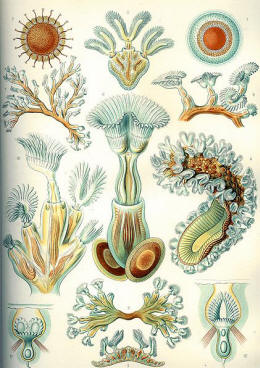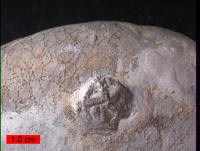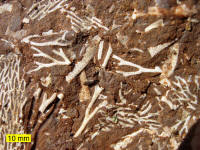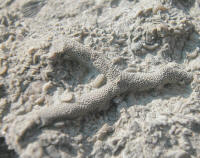Fossil Record
Fossils of about 15,000 bryozoan
species have been found. Marine
taxa with
mineralized skeletons
appear in rocks dating from the Arenigian stage of the Early Ordovician
period, about 480
million years ago. At this point all the
modern
orders of
stenolaemates were
present, and the
ctenostome order of
gymnolaemates had
appeared by the Middle Ordovician, about 465
million years ago. Other types of
filter feeders
appeared around the same time, which suggests that some change made the
environment more favorable for this lifestyle.
Fossils of
cheilostomates,
another order of gymnolaemates, first appear in the Mid
Jurassic, about 172
million years ago, and these have been
the most abundant and diverse bryozoans from the
Cretaceous to the
present. Evidence compiled from the last
100 million years show that cheilostomates consistently grew over
cyclostomates in territorial struggles, which may help to explain how
cheilostomates replaced cyclostomates as the
dominant marine bryozoans. Marine
fossils from the
Paleozoic era, which
ended 251
million years ago, are mainly of erect
forms, those from the
Mesozoic are fairly
equally divided by erect and encrusting forms, and more recent ones are
predominantly encrusting. Fossils of the soft, freshwater
phylactolaemates are
very rare, appear in and after the Late Permian
(which began about 260
million years ago) and consist entirely
of their durable statoblasts. There are no
known fossils of freshwater members of other classes.
Since all the other
phyla that have left fossils are found in
Cambrian rocks, it is
surprising that the earliest bryozoan fossil dates from the Ordovician,
which immediately followed the Cambrian. This suggests that the first
bryozoans appeared much earlier and were entirely soft-bodied, and the
Ordovician fossils record the appearance of mineralized skeletons in this
phylum. The Early Ordovician fossils may also represent forms that had
already become significantly different from the original members of the
phylum.
Description
Bryozoans,
phoronids and
brachiopods
strain food out of the water
by means of a
lophophore, a "crown"
of hollow tentacles. Bryozoans form colonies consisting of
clones
called zooids that are typically about 0.5 millimetres (0.020 in) long.
Phoronids resemble bryozoan zooids but are 2 to 20 centimetres (0.79 to
7.9 in) long and, although they often grow in clumps, do not form colonies
consisting of clones. Brachiopods, generally
thought to be closely related to bryozoans and phoronids, are distinguished
by having shells rather like those of
bivalves. All three of these
phyla
have a
coelom, an internal
cavity lined by
mesothelium. Some
encrusting bryozoan colonies with
mineralized
exoskeletons look very like small corals.
However, bryozoan colonies are founded by an ancestrula, which is round
rather than shaped like a normal zooid of that species. On the other hand
the founding polyp of a coral has a shape like that of its daughter polyps,
and coral zooids have no coelom or lophophore.
Entoprocts, another phylum of
filter-feeders, look rather like bryozoans but their lophophore-like feeding
structure has solid tentacles, their
anus
lies inside rather than outside the base of the "crown" and they have no
coelom.
Types of Zooid
All bryozoans are colonial except for one genus,
Monobryozoon.
Individual members of a bryozoan colony are about 0.5 millimetres (0.020 in)
long and are known as zooids, since they are
not fully-independent animals. All colonies
contain feeding zooids, known as autozooids, and those of some groups also
contain non-feeding specialist heterozooids;
colony members are genetically identical and co-operate, rather like the
organs of larger animals. What type of zooid
grows where in a colony is determined by chemical signals from the colony as
a whole or sometimes in response to the scent of predators or rival
colonies.
The bodies of all types have two main parts. The cystid consists of the body
wall and whatever type of
exoskeleton is
secreted by the
epidermis. The exoskeleton may be organic (chitin,
polysaccharide or
protein) or made of the mineral
calcium carbonate.
The body wall consists of the epidermis,
basal lamina (a mat of non-cellular
material),
connective tissue,
muscles, and the
mesothelium which
lines the
coelom (main body
cavity) – except that in one
class, the
mesothelium is split into two separate layers, the inner one forming a
membranous sac that floats freely and contains the coelom, and the outer one
attached to the body wall and enclosing the membranous sac in a
pseudocoelom. The other main part of the
bryozoan body, known as the polypide and situated almost entirely within the
cystid, contains the nervous system, digestive system, some specialized
muscles and the feeding apparatus or other specialized organs that take the
place of the feeding apparatus.
Feeding zooids
The
most common type of zooid is the feeding autozooid, in which the polypide
bears a "crown" of hollow tentacles called a
lophophore, which captures food particles
from the water. In all colonies a large
percentage of zooids are autozooids, and some consist entirely of
autozooids, some of which also engage in reproduction.
Avicularia and Vibracula
Some
authorities use the term avicularia to refer to any type of zooid in which
the lophophore is replaced by an extension that serves some protective
function, while others restrict the term to those that defend the colony by
snapping at invaders and small predators, killing some and biting the
appendages of others. In some species the
snapping zooids are mounted on a peduncle (stalk), their bird-like
appearance responsible for the term –
Charles Darwin described these as like "the
head and beak of a vulture in miniature, seated on a neck and capable of
movement". Stalked avicularia are placed upside-down on their stalks.
In vibracula, regarded by
some as a type of avicularia, the operculum is modified to form a long
bristle that has a wide range of motion. They may function as defenses
against predators and invaders, or as cleaners. In some species that form
mobile colonies, vibracula around the edges are used as legs for burrowing
and walking.
Other types of Colonial
Zooid
Kenozooids (from Greek κενος
meaning "empty") consist only of the body wall and funicular strands
crossing the interior, and no polypide. In some species they form the stems
of branching structures, while in others they act as spacers that enable
colonies to grow quickly in a new direction.
Spinozooids form defensive spines, and sometimes
appear on top of autozooids. Gonozooids act as brood chambers for fertilized
eggs. Some species have miniature nanozooids with small single-tentacled
polypides, and these may grow on other zooids or within the body walls of
autozooids that have degenerated.
Colony Forms and Composition
Although zooids are microscopic, colonies range in size from 1 centimeter
(0.39 in) to over 1 meter (3.3 ft). However,
the majority are under 10 centimeters (3.9 in) across.
The shapes of colonies vary widely, depend on the pattern of budding by
which they grow, the variety of zooids present and the type and amount of
skeletal material they
secrete.
Some marine
species are bush-like or fan-like, supported by "trunks" and "branches"
formed by kenozooids, with feeding autozooids growing from these. Colonies
of these types are generally
unmineralized but may
have
exoskeletons made of
chitin. Others look like small
corals, producing
heavy lime skeletons. Many species form
colonies which consist of sheets of autozooids. These sheets may form
leaves, tufts or, in the
genus
Thalmoporella,
structures that resemble an open head of
lettuce.
The most common marine form,
however, is encrusting, in which a one-layer sheet of zooids spreads over a
hard surface or over seaweed. Some encrusting colonies may grow to over
50 centimeters (1.6 ft) and contain about 2,000,000 zooids.
These species generally have exoskeletons reinforced with
calcium carbonate,
and the openings through which the lophophores protrude are on the top or
outer surface.
Some freshwater species secrete a mass of gelatinous material, up to 1 meter
(3.3 ft) in diameter, to which the zooids stick. Other freshwater species
have plant-like shapes with "trunks" and "branches", which may stand erect
or spread over the surface. A few species can creep at about 2 centimeters
(0.79 in) per day.
Each colony grows by
asexual
budding
from a single zooid known as the ancestrula,
which is round rather than shaped like a normal zooid.
This occurs at the tips of "trunks" or "branches" in forms that have this
structure. Encrusting colonies grow round their edges. In species with
calcareous
exoskeletons, these do not mineralize until the zooids are fully grown.
Colony lifespans range from one to about 12 years, and the short-lived
species pass though several generations in one season.
Species that produce
defensive zooids do so only when threats have already appeared, and may do
so within 48 hours. The theory of "induced
defenses" suggests that production of defenses is expensive and that
colonies which defend themselves too early or too heavily will have reduced
growth rates and lifespans. This "last minute" approach to defense is
feasible because the loss of zooids to a single attack is unlikely to be
significant.
End of Reading
Return to the
Old Earth Ministries Online Earth
History Curriculum homepage.

Source:
Bryozoa



